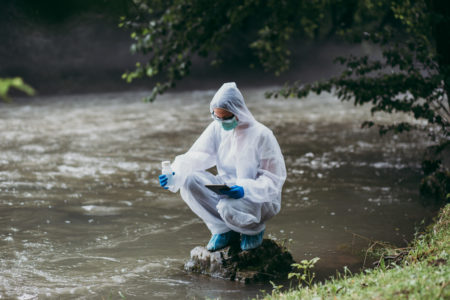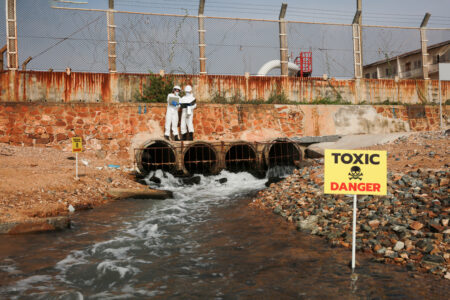
Share On Social!
Some chemicals cause serious harm and just don’t quit.
These substances, known as perfluorinated and polyfluorinated alkyl substances (PFAS), can be found in water, cosmetics, food packaging, fire-fighting foam, furniture, and other things that many come into contact with on a regular basis.
For years, researchers classified PFAS as permanent, undestroyable. Recent research shows, however, that might not be the case.
A study, published in the Journal of Environmental Engineering shows that a technique using water heat and pressure can annihilate 99% of PFAS in water.
How does this impact Latinos? Well, one recent National Institute of Environmental Health Sciences study showed that PFAS exposure can increase risk of type 2 diabetes in Latina girls.
Therefore, this research has beneficial implications for Latinos and all people, especially given this is a technique that could easily transition into the market, according to study lead, EPA researcher Max J. Krause.
“Given that supercritical water oxidation systems are already commercially available, this may be a technology that could soon be deployed for significantly impacted sites or wastewaters,” Krause told Keck School News. “We are currently evaluating air emissions to understand all of the pathways and to be certain we are destroying the PFAS.”
Update 6/16/22: The EPA issued a warning that PFAS pose health risks even at levels so low that can’t be detected, according to a news release.
The Study and Its Findings on PFAS, the ‘Forever Chemical’
Researchers tested how heat and water pressure specifically impacted PFAS—extremely harmful toxins that can be the cause of health issues, such as asthma, cancer and changes in the reproductive organs—found in water.
Their aim was to break carbon-fluorine bonds of these substances, which destroys the substances themselves.
The method, known as supercritical water oxidation, applies a temperature of 374 degrees Celsius at a pressure of more than 220 bars to break down these substances. The results were promising. This method destroyed 99% of PFAS in water.
The need to address PFAS is reinforced by another recent analysis that found the toxins in “nearly 75% of items labeled stain- or water-resistant.”
Companies are not taking the safety of their consumers into consideration when it comes to their use of PFAS in products, according Erika Schreder, one of the study’s co-authors and science director of Seattle-based Toxic Free Future.
“When companies use PFAS to make products stain- or water-resistant, they are using chemicals that contaminate homes, drinking water, and breast milk with highly persistent chemicals,” Schreder said, according to The Guardian.
PFAS and Impacts on Latinos
These substances cause the most harm when they leak into the ground and infect groundwater.
The contamination of water can present in numerous health issues.
Recent research by the Keck School of Medicine at USC has shown that this problem is impacting Latina girls, specifically.
Researchers looked more than 310 Latino children between ages 8-13 from the “Study of Latino Adolescents at Risk of Type 2 Diabetes.”
Each participant was tested for levels of certain PFAS at the start of the study. They were then followed for up to 12 years, with annual check-ups on how their bodies metabolized glucose.
“Because PFAS are in such widespread use and they don’t break down, they have made their way into the drinking water of roughly 200 million Americans,” said researcher Dr. Leda Chatzi of the the Keck School of Medicine at USC and director of the new USC Center for Translational Research on Environmental Health. “This is the first study to measure their potential impact on glucose metabolism over time among adolescents and young adults.”
Despite a lack of action from private businesses to clean up PFAS pollution, political policy might help in this issue.
The PFAS Action Act of 2021 was passed by the House of Representatives and received by the U.S. Senate in July of 2021. The bill is now awaiting review by the Committee on Environment and Public Works.
What You Can Do to Address Chemical Exposure
While major PFAS regulation may come from Washington D.C., you can take action to reduce Latinos’ harmful, toxic exposure — especially when it comes to food.
We have to create equitable, accessible healthy food access for Latinos and all people.
A few Salud America! Salud Heroes are working to this end: 
- Jorge Olvera is creating community gardens to fight food swamps in Houston.
- Flávia Fernandes is helping San Antonio residents with healthy cookbooks.
- Eloísa Trinidad started a vegan community fridge in New York
- David Miskie is bringing bilingually branded, healthier breakfast food into schools for Latino students.
Also, you can share important information on local food access with your decision-makers.
Just download a Salud America! Health Equity Report Card!
The report card will show you how you will see how your county is doing on food deserts, food access, the amount of fast-food restaurants, the amount of grocery stores, and more. The data is compared to the rest of your state and nation.
Email your Health Equity Report Card to community leaders and share it on social media. Use it to make the case to address healthy food access where help is needed most.
Explore More:
Chemical & Toxic ExposureBy The Numbers
1
Quick Survey
Can help you find out how chemically sensitive you are



